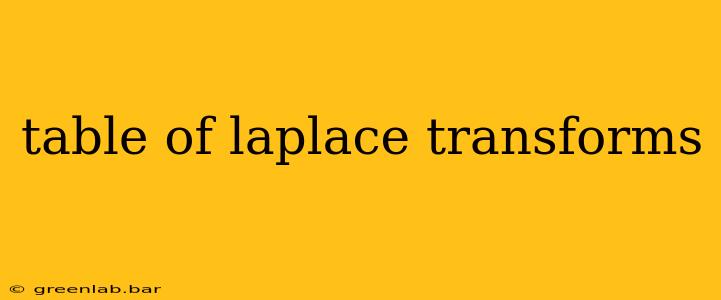This guide provides a comprehensive table of Laplace transforms, a crucial tool in solving linear ordinary differential equations (ODEs) and analyzing linear systems. We'll explore common transforms, their derivations (where applicable), and practical applications in various engineering and scientific fields. Understanding Laplace transforms is key for anyone working with dynamic systems.
Understanding the Laplace Transform
The Laplace transform converts a function of time, f(t), into a function of a complex frequency variable, s, denoted as F(s). This transformation simplifies the process of solving differential equations by converting them into algebraic equations, which are often much easier to manipulate. The inverse Laplace transform then converts F(s) back into the time domain f(t), providing the solution to the original differential equation.
The general formula for the Laplace transform is:
F(s) = L{f(t)} = ∫₀^∞ e^(-st) f(t) dt
Where:
f(t)is the function of time.sis the complex frequency variable (σ + jω).Ldenotes the Laplace transform operator.- The integral is evaluated from 0 to infinity.
Table of Common Laplace Transforms
The table below lists common functions and their corresponding Laplace transforms. Note that this is not an exhaustive list, but covers many frequently encountered functions.
| f(t) | F(s) | Conditions | ||
|---|---|---|---|---|
| 1 | 1/s | s > 0 | ||
| t | 1/s² | s > 0 | ||
| tⁿ (n=1,2,3...) | n!/sⁿ⁺¹ | s > 0 | ||
| e^(at) | 1/(s-a) | s > a | ||
| sin(ωt) | ω/(s²+ω²) | s > 0 | ||
| cos(ωt) | s/(s²+ω²) | s > 0 | ||
| e^(at)sin(ωt) | ω/((s-a)²+ω²) | s > a | ||
| e^(at)cos(ωt) | (s-a)/((s-a)²+ω²) | s > a | ||
| t*e^(at) | 1/(s-a)² | s > a | ||
| δ(t) (Dirac Delta) | 1 | - | ||
| u(t) (Unit Step) | 1/s | s > 0 | ||
| t² | 2/s³ | s > 0 | ||
| sinh(at) | a/(s²-a²) | s > | a | |
| cosh(at) | s/(s²-a²) | s > | a |
Applications of Laplace Transforms
Laplace transforms find widespread use in various fields, including:
- Control Systems Engineering: Analyzing the stability and performance of control systems.
- Electrical Engineering: Solving circuits with capacitors, inductors, and resistors.
- Mechanical Engineering: Modeling and analyzing mechanical vibrations and dynamic systems.
- Signal Processing: Filtering and analyzing signals in the frequency domain.
- Physics: Solving differential equations that describe physical phenomena.
Beyond the Table: Important Considerations
This table provides a foundation. More complex functions often require the use of properties of Laplace transforms, such as linearity, time shifting, frequency shifting, differentiation, and integration properties, to derive their transforms. Mastering these properties is essential for effectively using Laplace transforms in problem-solving. Furthermore, the use of partial fraction decomposition is frequently necessary when performing the inverse Laplace transform to obtain a time-domain solution.
This comprehensive guide offers a solid understanding of Laplace transforms and their applications. Remember to consult advanced textbooks and resources for a deeper dive into more complex scenarios and advanced techniques. With practice and a solid grasp of the fundamental principles outlined here, you'll be well-equipped to tackle various engineering and scientific challenges.

